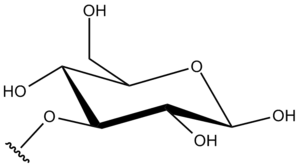Glycosyl

A glycosyl group is a univalent free radical or substituent structure obtained by removing the hemiacetal hydroxyl group from the cyclic form of a monosaccharide and, by extension, of a lower oligosaccharide. Glycosyl also reacts with inorganic acids, such as phosphoric acid, forming an ester such as glucose 1-phosphate.
Examples
In cellulose, glycosyl groups link together 1,4-beta-D-glucosyl units to form chains of (1,4-beta-D-glucosyl)n. Another example is ribityl in 6,7-Dimethyl-8-ribityllumazine.
Substituent groups other than glycosyl groups

Instead of the hemiacetal hydroxyl group, a hydrogen atom can be removed to form a substituent, for example the hydrogen off the hydroxyl on C3 of a glucose molecule. Then the substituent is called D-glucopyranos-3-O-yl[1] as it appears in the name of the drug Mifamurtide.
See also
- Acyl group